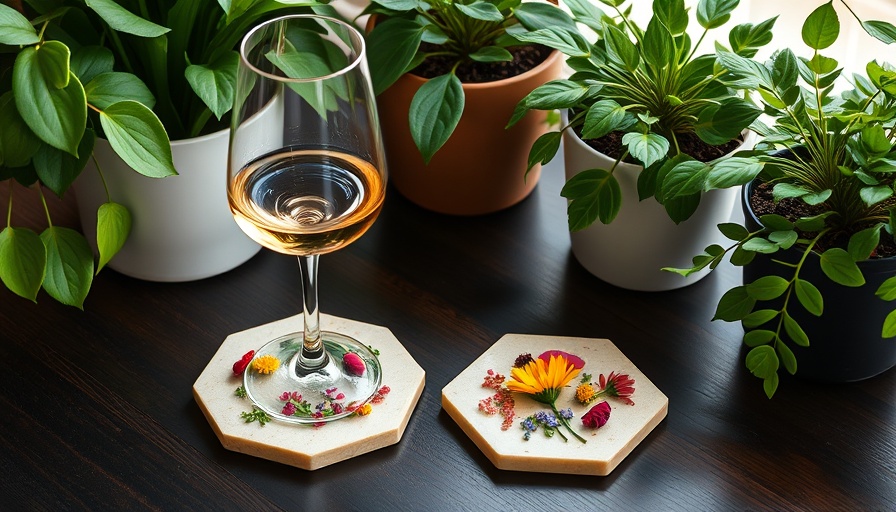
Transform Your Memories: Create Stunning Resin Coasters with Pressed Flowers
Have you ever wished to preserve the beauty of your garden or those special flowers from a memorable event? Creating resin coasters adorned with pressed garden flowers is not just a delightful DIY project; it's a chance to encapsulate cherished memories in a stunning form. These coasters offer not only a practical use but also serve as heartfelt gifts for friends and family, infusing any space with a touch of nature's beauty.
Why Create Resin Coasters?
Resin coasters made with dried flowers provide a unique way of relishing the visual charm of your favorite blooms all year round. Whether it's flowers from your garden or a special bouquet from an occasion, these coasters can immortalize those fleeting moments. Beyond aesthetics, they are practical for use with both hot and cold drinks, guaranteeing that your coffee table is not just stylish but also functional.
Gathering Your Materials: What You'll Need
Before diving into this artistic endeavor, it's essential to assemble the right materials to ensure a smooth crafting experience. You’ll need:
- Resin and hardener (commonly sold as kits)
- Silicone coaster molds (at least 4 inches in diameter)
- Dried flowers (either purchased or pressed from your garden)
- Gold flakes (for added flair)
- Disposable cups and wooden sticks for measuring and mixing
- Protective gear such as gloves and eyewear
Having all these materials prepped and organized will make the process feel seamless. Remember, resin is time-sensitive, so preparation is key!
The Process: Step by Step
Creating beautiful resin coasters can be broken down into manageable steps:
- Preparation: Clean your molds thoroughly to avoid any unwanted particles ending up in your finished product. Lay out your workspace with a protective covering to manage sticky resin spills.
- Mix the Resin: Follow the instructions of your resin kit closely. Generally, mix equal parts of resin and hardener until fully combined, stirring slowly to minimize bubbles.
- Design Your Coasters: Before pouring, design the layout of your flowers in the mold. Play with the colors and shapes, ensuring each coaster will reflect your creativity.
- First Pour: Pour a layer of resin into the molds, filling them about a third of the way. Allow the resin to sit for a short period (approximately 15 minutes) before adding your pressed flowers.
- Adding Flowers: Carefully place your dried flowers into the resin, using tweezers to position them as desired. Ensure they are submerged well in the resin.
- Second Pour: Once arranged, pour another layer of resin over the flowers to fully encase them, then cover your molds to protect them from dust.
- Cure Time: Let your coasters cure as per the resin instructions (typically 24-48 hours). This step is crucial for a durable coaster.
- De-mold: After the curing period, gently remove the coasters from their molds, and enjoy your beautiful, custom creations!
Valuable Lessons from DIYers
As with any crafting project, patience and practice are your best allies. Many first attempts may yield imperfect results, but each mistake teaches valuable lessons. Whether it’s figuring out the ideal flower placement or understanding the nuances of resin mixing, the journey itself adds to the joy of crafting.
Environmental Connection and Lifestyle Benefits
Making resin coasters from pressed flowers is more than just a craft; it resonates with sustainable practices and the joy of gardening. By using blooms you’ve nurtured, you’re contributing to a personal and environmentally-conscious lifestyle. This project allows others to witness the beauty of what you've grown, bridging the gap between your living space and the outdoor world.
Embracing the Beauty of Nature in Your Home
These resin coasters not only protect your surfaces but also breathe life and color into your space. Consider them as conversation starters during gatherings or as a beautiful representation of your passion for gardening. They encapsulate the essence of seasons past, reminding you of sunny days spent among the flowers.
Conclusion: Get Started on Your Resin Coaster Journey!
Now that you are equipped with the knowledge and insights on how to craft resin coasters with pressed garden flowers, it’s time to bring this project to life! Gather your materials, explore your creativity, and enjoy the process. With every pour and placement, you grow not just as a crafter but as a storyteller of your own floral memories.
Whether you're gifting these coasters to celebrate life’s milestones or simply decorating your own home, the satisfaction derived from creating something beautiful and functional is immeasurable.
Let each coaster be a reminder of the beauty that surrounds us and a testament to your creativity!
 Add Row
Add Row  Add
Add 




Write A Comment